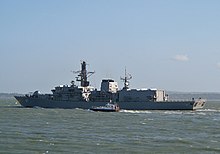HMS Grafton (F80)
This article needs additional citations for verification. (September 2014) |
 HMS Grafton (F80)
| |
| History | |
|---|---|
| Name | HMS Grafton |
| Namesake | Duke of Grafton |
| Operator | Royal Navy |
| Ordered | January 1992 |
| Builder | Yarrow Shipbuilders |
| Laid down | 13 May 1993 |
| Launched | 5 November 1994 |
| Commissioned | 29 May 1997 |
| Decommissioned | 31 March 2006 |
| Identification | F80 |
| Fate | Sold to Chile |
| Name | Almirante Lynch |
| Namesake | Patricio Lynch |
| Operator | Chilean Navy |
| Commissioned | 28 March 2007 |
| Identification | FF-07 |
| Badge | |
| General characteristics | |
| Class and type | 'Duke'-class Type 23 frigate |
| Displacement | 4,900 tonnes |
| Length | 133 m (436 ft) |
| Beam | 16.1 m (53 ft) |
| Draught | 7.3 m (24 ft) |
| Propulsion |
|
| Speed |
|
| Range | 7,800 nmi (14,400 km; 9,000 mi) at 15 kn (28 km/h; 17 mph) |
| Complement | 185 |
| Armament |
|
| Aircraft carried | 1 × Lynx HMA8 helicopter |
HMS Grafton was a Type 23 frigate of the Royal Navy. She was the ninth vessel to bear the name, and is named after the Duke of Grafton.
Ordered in January 1992, Grafton was laid down on 13 May 1993 by Yarrow Shipbuilders. The frigate was launched 5 November 1994 and commissioned into the Royal Navy on 29 May 1997 with the pennant number F80.
Design
Designed to replace the Template:Sclass-, the Type 23 frigate's operational role as an anti-submarine warfare platform. They are 133 metres (436 ft) long with a beam of 16.1 m (53 ft), a draught of 7.3 m (24 ft) and displace 4,900 tonnes.
They are propelled by a CODLAG (Combined Diesel-eLectric And Gas) with two Rolls-Royce Spey boost gas-turbines and four Paxman Valenta diesel engines. They are also equipped with two GEC electric motors. This gives the ships a maximum speed of 28 knots (52 km/h; 32 mph) and 15 kn (28 km/h; 17 mph) on diesel-electric. The vessels have an effective range of 7,800 nautical miles (14,400 km; 9,000 mi) at 15 kn (28 km/h; 17 mph).
Armament
Designed to replace the Template:Sclass-, the Type 23 frigate's operational role as an anti-submarine warfare platform. The design grew to encompass the Sea Wolf and Harpoon missile systems for air defence and anti-ship purposes respectively. They were also equipped with one BAE 4.5 inch (113 mm) Mk 8 gun.
For anti-submarine purposes they have four Sting Ray torpedo tubes. For anti-missile defence they have Seagnat and DFL3 decoy launchers.
Service history
In 2003, the ship was used in the ITV drama series Making Waves as the fictional Royal Navy warship Suffolk. In early 2004 the ship was deployed in the Persian Gulf. In July 2004, it was announced that Grafton would be one of three Type 23 frigates to be decommissioned by the end of 2006.
In June 2005, it was announced that Grafton would be sold to the Chilean Navy . During her service in the Royal Navy, her crew were awarded the freedom of the Borough of Ipswich, due to their frequent visits to the Suffolk town. On her last visit to Ipswich in 2006, the Ship's Bell was presented to the town as a permanent reminder of the links between Grafton and Ipswich. The bell is now on display in the reception area of the Ipswich Borough Council offices at Grafton House, named for the connection to the warship.[1] She was decommissioned on 31 March 2006.

The frigate was delivered to Chilean Navy on 28 March 2007 at Portsmouth and renamed Almirante Lynch (FF-07) after Patricio Lynch.
References
- ^ Ipswich Borough Council, display at Grafton House, 15-17 Russell Road, Ipswich IP1 9SA
Publications
- Colledge, J. J.; Warlow, Ben (2006) [1969]. Ships of the Royal Navy: The Complete Record of all Fighting Ships of the Royal Navy (Rev. ed.). London: Chatham Publishing. ISBN 978-1-86176-281-8.
